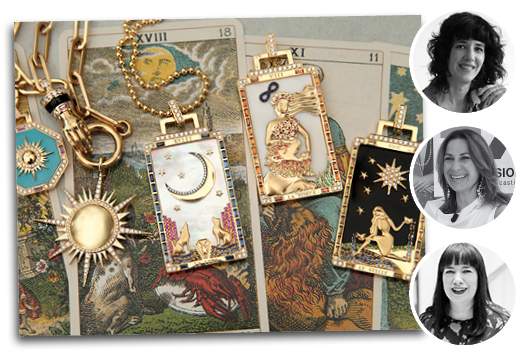
Trend forecasting is a term people have over-zealously applied to everything from retail sales pitches to shots of eccentric street style. This has lent a frivolous image to an industry that’s more likely to drill down into data than buff a crystal ball when determining which jewels we’ll buy and why. In a year of unpredictable world events, trend forecasters have had their mettle tested, but they’ve come out swinging.
“We have been a really valuable source of insight and confirmation for our clients throughout the pandemic and have been agile enough to create content in direct response to it as it happens,” says Claire Foster, head of accessories and footwear at WGSN Fashion, a trend forecasting and analytics business.
Rather than ripping up their 2020 predictions after everything plunged into uncertainty, Foster and other jewelry-sector forecasters have found that their reports from before this seismic year are holding true. If anything, the pandemic accelerated many preexisting trends. Foster points to a WGSN trend titled “Home Hub,” which foresaw consumers investing more heavily in their homes and spending more time there. This was expected to grip consumers in spring-summer 2021, Foster notes, but needless to say, the lockdowns sped things up.
The big picture
More jewelry-specific trends that the pandemic has spurred on include talismanic and symbolic pieces, as well as the adoption of digital strategies, says Paola De Luca, founder of luxury creative intelligence agency The Futurist. “The pandemic only accelerated the inevitability of what was supposed to happen.”
This is partly because trend agencies’ work goes much deeper than simply strolling around trade shows and noting the most popular styles. Creating a jewelry trend forecast, as opposed to a reactionary show report, requires factoring in influences from outside the industry.
“A trend is a general direction [toward] which something is changing or evolving,” explains Maia Adams, cofounder of jewelry-trend and market intelligence firm Adorn Insight, though she notes that overuse of the word has blunted its power. On a global level, she says, diamond jewelry is subject to concerns similar to other industries’ — “sustainability, new generations, maintaining relevance.” The value a business like hers can bring is that it has teams of people “identifying emerging changes and predicting outcomes.”
Part of trend forecasters’ image problem is that when those outside the business hear the word “trend,” they look for something tangible and easy to spot, like hoops or east-west settings. Forecasters, however, are looking for what can’t be seen — what could happen in the future based on wider socioeconomic developments or shifts in technology, politics, global movements and business. They then try to decide how that might affect the style of jewels consumers unconsciously favor.
Delving into details
“The Futurist is based on data collection, clear metrics,” states De Luca, who recently launched a project entitled “What Is the Future of Diamonds?” “We don’t do prophecies, we are not imagining [trends]; we are analysts.”
Compiling such data is a complex business. The Futurist has a global network of correspondents all feeding market information back to a central hub. Adorn Insight says a single trend report is the result of six months of research.
At WGSN, says Foster, “we use a huge range of research points for our range of forecasting content, analyzing the trends in design, fashion, media, film, etc. We take note of shifts in society, technology, the economy, politics and industry, [as well as] data analysis of retail, social media and Google search terms, alongside a team of experts positioned globally collecting primary research and feeding back insights to the wider team. Research is the bedrock of our work.”
How people use this information varies. Trend reports are an easily digestible format and are handy for stores that want an overview of the market. The Natural Diamond Council’s (NDC) newly launched trend reports, for instance, are a good entry point for stores seeking real-time fine-jewelry trend information. However, these often make up a small portion of the work. Agencies frequently work directly with single clients — be they retailers, miners, wholesalers or trade shows — to create specific strategies. Some work with government bodies as well; in The Futurist’s case, those include the Indian government, Turkey’s JTR Jewellery Exporters’ Association, and the Italian Trade Agency. The strategies might cover product buying or design, but could also shape store environments, packaging, digital tone of voice, corporate culture, or anything else that jewelry companies need to future-proof their activities.
Though this year has shaken every aspect of the jewelry business, it has shown us that the ability to anticipate outcomes and plan ahead is crucial, making serious trend forecasting a more relevant practice than ever.
Image: SorellinaArticle from the Rapaport Magazine - December 2020. To subscribe click here.